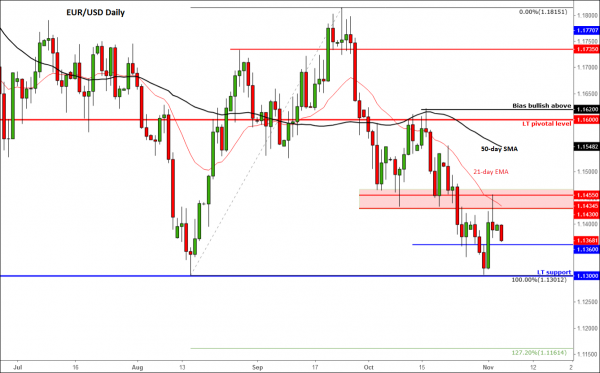The EUR/USD’s sharp rebound from long-term support at 1.13 came to an abrupt halt on Friday and the weakness has persisted at the start of this week, although so far, we haven’t seen any significant follow-through. The single currency came under pressure from several sources, including reports that the ECB is considering fresh TLTROs, the ongoing clash between Italy and the EU over the former’s budget and weakness in Eurozone data. Meanwhile there was fresh evidence of a strong US economy as the latest monthly jobs report there came out well ahead of expectations and average hourly earnings rose at its highest clip since the financial crisis in 2009. But ahead of the mid-term elections on Tuesday, speculators were understandably hesitant to establish any bold positions in the dollar. So, the EUR/USD and the FX markets in general were fairly quiet at the time of writing.
Rumours circulated on Friday that the ECB is planning to re-issue targeted longer-term refinancing operations (TLTROs) so that financing does not dry up for banks in the Eurozone next year. Finnish Central Bank governor Olli Rehn said: “If needed, we will then consider the whole toolbox that we have at our disposal,” when asked by a reporter about the possibility of new TLRTOs. The old 4-year TLTROs expire in mid-2020 and so the ECB and banks that use such loans must decide well before then how to replace them. With Eurozone lenders still relying on these cheap loans, this can’t be a good sign.
What’s more, Italy’s budget dispute with the EU continues and it doesn’t look like Italy are backing down. The Italian coalition government has clashed with Brussels after it proposed to sharply increase spending on welfare and cut taxes. At the weekend, deputy prime minister, Luigi Di Maio, who heads Italy’s coalition party Five Star Movement, backed Donald Trump’s economic policies and warned the EU against “failed” austerity theories. He said: “The US economy is growing at four per cent with the expansive policies of Trump, which everyone said were wrong. He is expanding the deficit, lowering taxation and investing in infrastructure. I believe that over the next 10 years Europe will go in this direction because the United States is moving in this direction.”
Moreover, incoming data from the Eurozone continues to disappoint and today saw a leading Eurozone economic confidence survey signal further declines. The Sentix Investor Confidence, which is based on a survey of 1,000 investors, printed its lowest reading since October 2016. After falling for each of the past four months, the gauge now stands at 8.8 in November.
US mid-term elections key short-term focus for dollar, stocks
The focus is now on US mid-term elections, which will decide control of the US Congress and help set the course for the rest of President Donald Trump’s term in the White House. Its outcome could have major implications for the markets. Generally speaking, Republicans are seen as more being business-friendly than the Democrats and therefore if they were to maintain control of both houses then this should be good news for stocks and the dollar in terms of immediate reaction. After all, a Republican-controlled Congress will make the remaining two years of Trump’s first term much smoother. He would have the power to for example to pass further tax cuts. However, the Democrats looks set to gain lots of seats and should they regain control, then some of Trump’s key policies will face fierce opposition. In this potential outcome, we could actually see both the dollar and stocks sell-off sharply. In the very short-term outlook, today’s ISM services PMI could potentially move the dollar if it deviates significantly from the expected figure of 59.3.
Technical outlook
From a technical point of view, the lower lows and lower highs observable on the charts of the EUR/USD means price action is still bearish. Friday’s turnaround resulted in the formation of a hammer-like candlestick pattern on the daily time frame of the EUR/USD around the downwardly-sloping 21-day exponential moving average, which is a further bearish signal. What’s more, resistance around 1.1430-55 area held. At the time of writing, price was approaching Wednesday’s high and short-term support around 1.1350/60 area. If this area fails to hold up price, then a breakdown of that long-term 1.1300 support would become likely. If that happens then depending on price action at the time, we could see further sharp declines towards 1.12 or even mid-1.11s over the subsequent days. Meanwhile if support holds here and we go above Friday’s high then in this event we could see a short squeeze rally towards mid-1.15 or even higher.


 Signal2forex.com - Best Forex robots and signals
Signal2forex.com - Best Forex robots and signals




